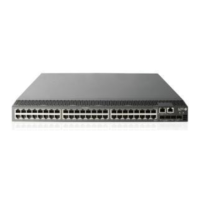1
Using the CLI
At the command-line interface (CLI), you can enter text commands to configure, manage, and monitor
your device.
You can use different methods to log in to the CLI, including through the console port, Telnet, and SSH.
For more information about login methods, see "Logging in to the CLI."
FIPS compliance
In Release 1118 and later versions, the device supports the FIPS mode that complies with NIST FIPS 140-2
requirements. Support for features, commands, and parameters might differ in FIPS mode and non-FIPS
mode. For more information about FIPS mode, see Security Configuration Guide.
Command conventions
Command conventions help you understand the syntax of commands. Commands in product manuals
comply with the conventions listed in Table 1.
Table 1 Command conventions
Convention Descri
tion
Boldface Bold text represents commands and keywords that you enter literally as shown.
Italic Italic text represents arguments that you replace with actual values.
[ ] Square brackets enclose syntax choices (keywords or arguments) that are optional.
{ x | y | ... }
Braces enclose a set of required syntax choices separated by vertical bars, from which
you select one.
[ x | y | ... ]
Square brackets enclose a set of optional syntax choices separated by vertical bars, from
which you select one or none.
{ x | y | ... } *
Asterisk marked braces enclose a set of required syntax choices separated by vertical
bars, from which you select at least one.
[ x | y | ... ] *
Asterisk marked square brackets enclose optional syntax choices separated by vertical
bars, from which you select one choice, multiple choices, or none.
&<1-n>
The argument or keyword and argument combination before the ampersand (&) sign can
be entered 1 to n times.
# A line that starts with a pound (#) sign is comments.
Command keywords are case insensitive.
The following example analyzes the syntax of the clock datetime time date command according to Table
1.

